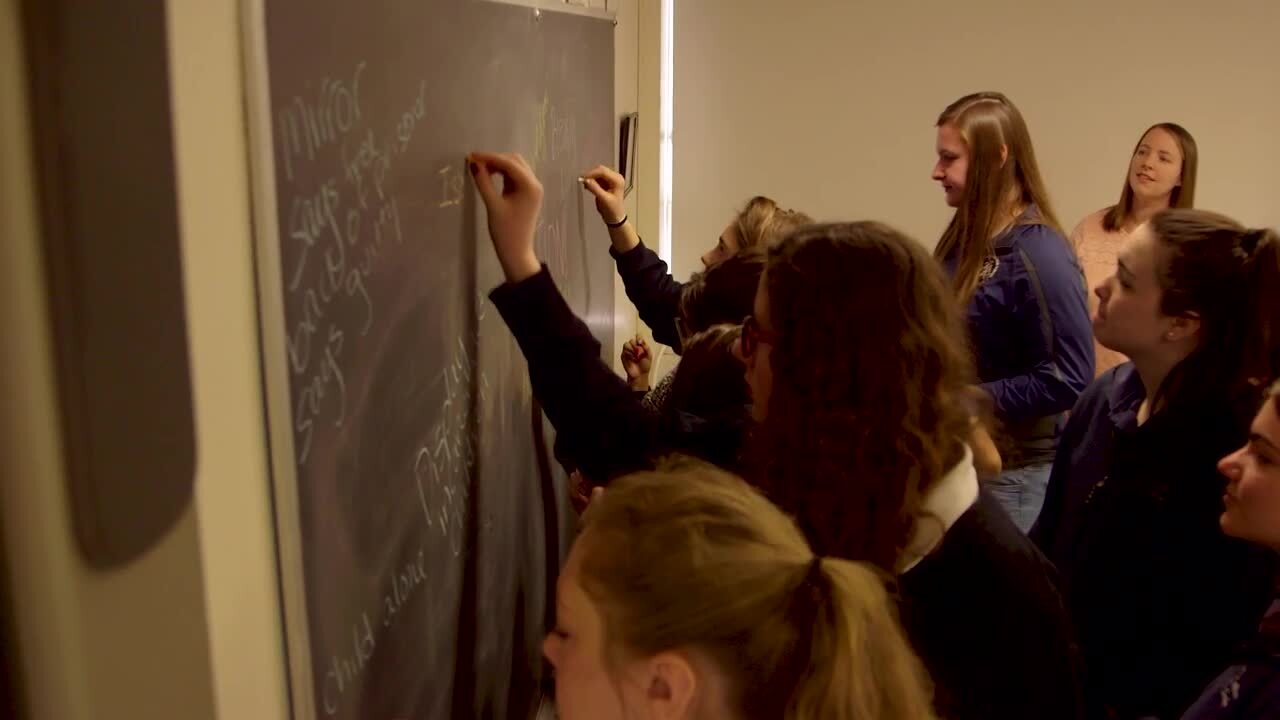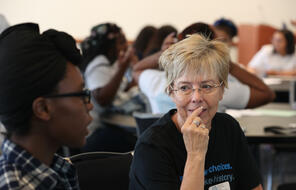JENNY STAYSNIAK: The Graffiti Board Strategy is a great way to get everyone involved in the lesson, particularly those who might be a little on the shy side or quiet side. So you have students typically come to one big space. If you have one large chalkboard, it's perfect-- or a whiteboard. So I have students all come to the chalkboard. They grab a piece of chalk. And it's centered around a prompt. So I'm asking them, I want you to just brainstorm. Write down all the ideas you can think of as fast as you can. And in the words of graffiti or tagging the board, right? So you're writing down all your thoughts on the board, and you're observing what other people are writing. It's a little chaotic, but it's fun. And students get into it. If you have a limited amount of space, what I ask to do is have students take a step back and let others move forward. And while you're taking a step back, to observe what everyone's writing. So at the end, what you should have is a representation of all these different thoughts. Though silent, in terms of speaking, is very much the voice of students. And it gets people really brainstorming together and playing off one another's ideas and threads. So I think the Graffiti Board Strategy is an excellent way to really get those quieter students involved. But also to have maybe a student who's on opposite side of the classroom talking to one another through writing, that maybe for an entire month, if that's the seating chart, they don't get to talk during class. And I really like students to be able to rotate who they're communicating with and who they're bouncing ideas off of. And the Graffiti Board is a great way to do that. I'm going to ask you to all come up to the chalkboard. And we have a variety of colors. Yes? I want you to choose a piece of chalk, and I want you to, as fast as you can with the little time we have remaining, I want you to write down just all the ideas you have in your brain. Just get them out there about what you might want to do for your memorial. Questions? All right. Come on up. [CHATTER] Once you write something down, maybe take a step back too so someone else can get in there. And then when you take a step back, feel free to maybe look over shoulders and read what people have written. I'm seeing some great stuff. I see barbed wire handcuffs, freedom, a child alone behind bars. [CHATTER, LAUGHTER] I see isolation. Mirror that says free on one side and guilty on the other. That is good. [CHATTER] Something with prison cells and bars, cell numbers. STUDENT 1: So wait. What's that say? JENNY STAYSNIAK: Freedom? Freedom. [CHATTER] So breaking down a wall between the two sides. If you have any other thoughts, go on up there. If you did take a step back already, make sure you're reading what you see. And remember, this is a collective effort like our class is collective, right? So even though you're all going to have individual projects, play off of one another's strengths and ideas. I see something going on with the 13th Amendment there, which makes me super happy because we learned so much about the 13th Amendment and its effect on the prison system today. [CHATTER, LAUGHTER] I see a lot of different materials up here. I see glass frequently. What are some of the trends we see? Anyone? SIOBHAN: Breaking things down. LYDIA: Inside of prison. JENNY STAYSNIAK: Siobhan just said, breaking things down. Lydia said, what's happening inside of prisons. STUDENT 2: Parentless children. JENNY STAYSNIAK: Parentless children. Things we've been talking about, right? What else do we see? STUDENT 3: Lack of freedom. JENNY STAYSNIAK: A lack of freedom. STUDENT 4: A lot of barbed wire and just prison cells. JENNY STAYSNIAK: Handcuffs, barbed wires, and prison cells. STUDENT 5: Race. JENNY STAYSNIAK: Rights. STUDENT 6: Race. JENNY STAYSNIAK: Oh, yes. Race. Lydia added race to this. We have to always keep in mind definitely the racial discrimination when it comes to the prison industrial complex. Isn't that beautiful? STUDENT 7: Mm-hmm. JENNY STAYSNIAK: All right. Why don't you have a seat? LYDIA: Empathy. JENNY STAYSNIAK: Did everyone hear what Lydia just said? STUDENT 8: No, what'd she say? JENNY STAYSNIAK: She said empathy. STUDENT 9: Oh, my gosh. STUDENT 10: Where did you write it? JENNY STAYSNIAK: So in just those two minutes, look at this beautiful creation of ideas that you've all come up with. STUDENT 11: We can post that but with our pictures. JENNY STAYSNIAK: Well, I'm going to take a picture of this so that we have it as a historical record of the narrative of this project. Are you all excited to make it? STUDENTS: Yeah. JENNY STAYSNIAK: All right. And I'm really excited that the graffiti board, how well they played off of each other. I think it was nice how they all just gave each other space and stepped back. It took a little bit of work for me to say, all right, take a step back and re-enter the space and look at what everyone's looking at. But I was happily surprised how well and fluid the whole graffiti board worked.














